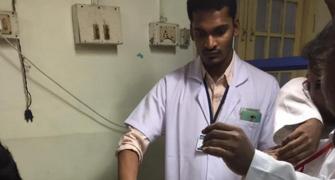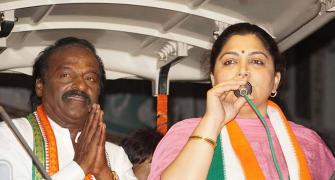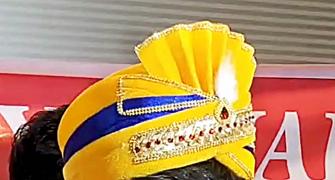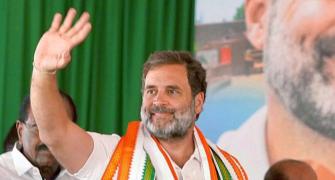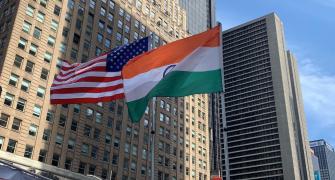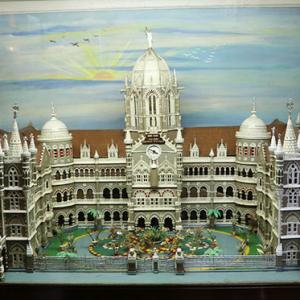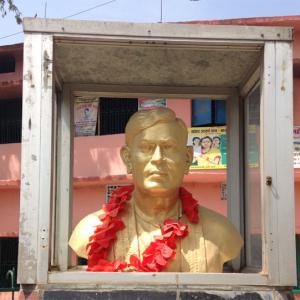
'He was an amazing combination of a fantastic artist and a great scholar and teacher.'
'A good way of paying homage to this thinker, and for us and the future generations to benefit from his ideas, would be to keep his writings available and alive.'
Rediff.com's Uttam Ghosh attends a meeting to pay homage to K G Subramanyam, one of India's most interesting painters and thinkers.
As an art student in the early eighties, my only exposure to K G Subramanyan, or KG as he was popularly known, was through text books and the little bits of information our teachers shared with us.
That he was an artist who had a tremendous impact in giving Indian art a new direction was something I came to know much later.
KG succumbed to that final master, death, on June 29 at the ripe old age of 92.
Mumbai honoured this celebrated artist -- he was a painter, sculptor, muralist, print maker, writer and academic (lecturer at the faculty of fine arts, M S University, Baroda and, later, Kala Bhavan, Visva Bharti University, Santiniketan) though a memorial meeting, where artists from the city shared their memories.
KG's influence was such that even the vagaries of a rainy day did not stop an eminent gathering of over 60 people from making it to the venue, the National Gallery of Modern Art in southern Mumbai.

A notice board announces the memorial meeting at the National Gallery of Modern Art.
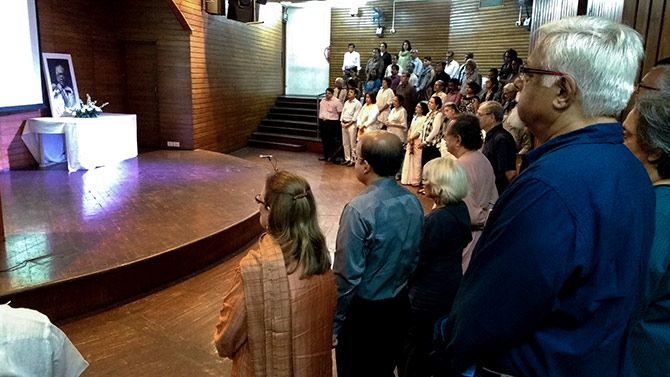
Despite the gloominess of a wet monsoon day, over 60 people made it to the venue
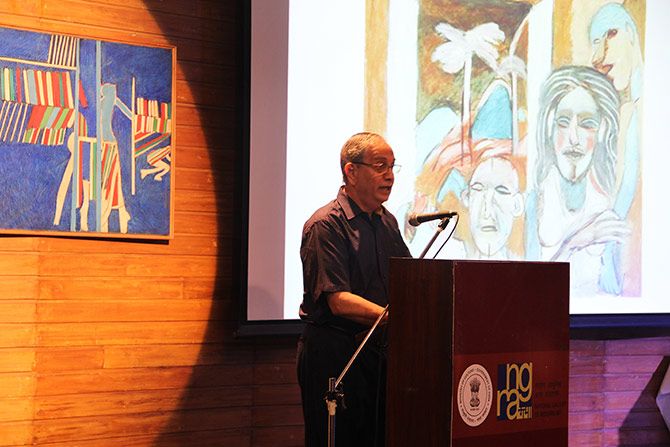
In his tribute, contemporary painter Sudhir Patwardhan (above) said, "Manida to most and KG to some, he was one who inspired at least three generations of artists in Baroda, Santiniketan and the rest of the country. He will be dearly missed as a human being, as an artist, as a teacher and as a thinker who gave us the conceptual frame work for an alternative modernism."
"I was not a student, but I always saw him as someone to learn from. I found his work and writings stimulating and challenging... challenging because he proposed a model of modernity that was essentially different from the western European style modern that was my context in Bombay in the seventies."
"And so, in 1987, I spent around three weeks in Santiniketan talking to Manida about his ideas and also learning terracotta and clay modelling art under his guidance."
"Manida’s views were developed in his years in Santiniketan as a student with teachers like Nandalal Bose, Benode Behari Mukherjee and Ramkinkar Baij and also from his exposure to and thinking about modernism in Europe and America. He created a conceptual framework for an alternative modernism rooted in local conditions, in classical and folk traditions, in crafts that were still alive and at the same time was responsive to change and development and to individual creativity."
"His contribution to the idea of art as language is very important."
"A good way of paying homage to this thinker, and for us and the future generations to benefit from his ideas, would be to keep his writings available and alive."
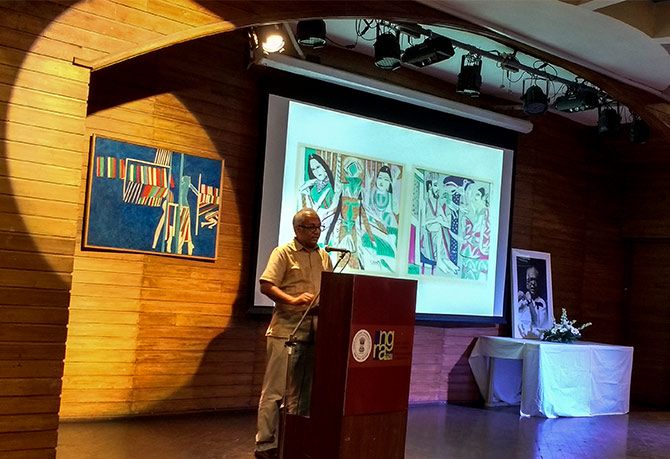
Atul Dodiya (above), who spoke later, said, "I was not privileged; I was never his student, but a generation of artists and those who studied art under him still talk about him. If you go today to Santiniketan, you will find young students who will say that was Manida here and he said this and he did that..."
"He belonged to the generation of artists like M F Husain, (Francis Newton) Souza, (Syed Haider) Raza, (Vasudeo S) Gaitonde, Akbar Padamsee, Ram Kumar, Tyeb Mehta... this group of artists where I could see some sort of a bond in terms of their style and in terms of what they were doing. And, of course, then there was Subramanyan who was slightly different towards his approach."
"I felt KG was influenced by Henri Matisse (in terms of the) colors, forms and the playfulness. But then, when I started looking at more of his works, they were terracotta, there were murals, paintings, drawings, reverse paintings on glass all kinds of experiments in terms of materials."
"He was an amazing combination of a fantastic artist and a great scholar and teacher."
"KG's role is amazing in the development of the narrative school of Baroda. He advised Bhupen Khakhar also."
"KG could speak on any subject -- be it politics or social, you name it and he would get involved in it and talk about it."
"When we met him recently he said, 'I read the papers and Modisaab says, Acche din ayege lekin do saal ho gaye, pata nahin kab ayenge (Mr Modi says good days will arrive but it has been two years (since he came to power) but I still don't know when the good days will come)."
"He had a great sense of humour. It was fun talking to him. At some points, he would be very sarcastic and blunt about what he felt."
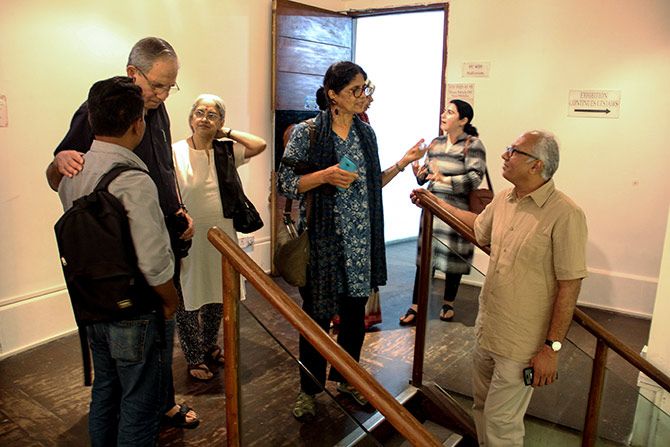
Sudhir Patwardhan (in black), Shakuntala Kulkarni (in blue) and Anju (second from right) and Atul Dodiya (right) catch up after the memorial meeting.
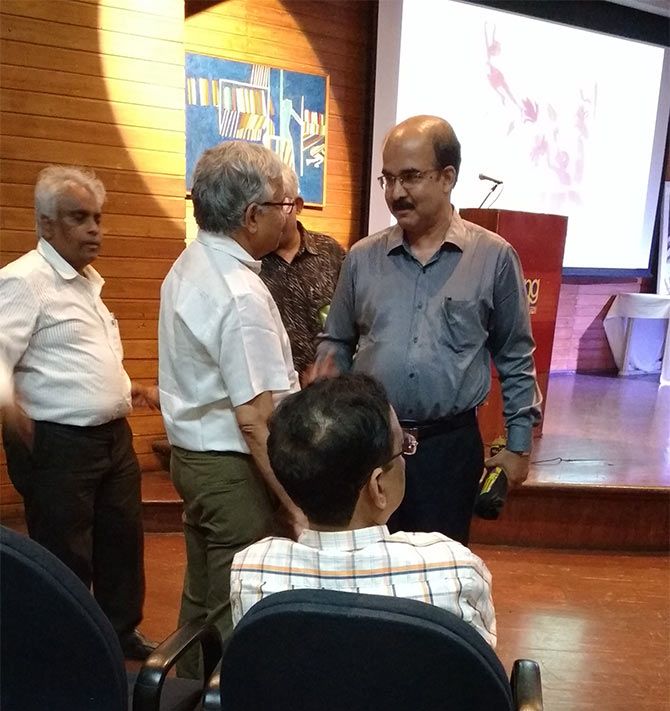
Sabyasachi Mukherjee (in grey), director general, the Chhatrapati Shivaji Maharaj Vastu Sangrahalaya (formerly known as the Prince of Wales museum), was there as well.
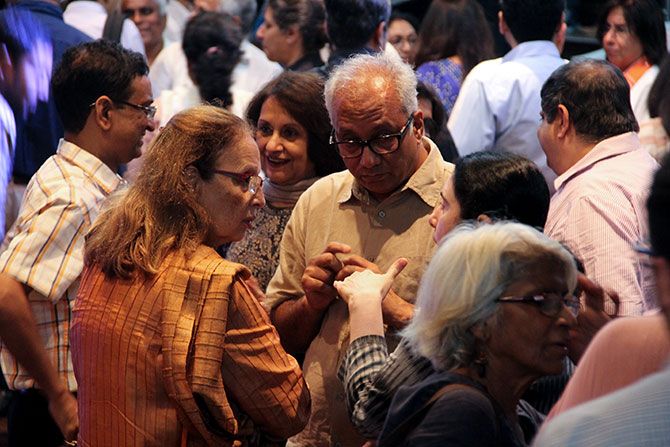
Pheroza Godrej, who later caught up with Atul and Anju Dodiya, added, "I am happy that KG's daughter Uma's husband, Mr Padmanabhan, is here. It is a sad occasion, but we must also celebrate Subramanyan's life; he has left us a lot to celebrate with."
"K G Subramanyan stands apart from artists who either latched on to the bandwagon of post modernism or succumbed to the creation of theoretical works of overwhelming socio-political cultural cross currents."
"He stands apart by having contributed to work serenely in the manner of the great masters of the early part of this century, experimenting and exploring various media and evolving a highly personalised vocabulary of images unmoved by the dictates of fashionable art theory."
"It is from his paintings that we realise that Subramanyan's is a universal pictorial language originating out of shared science and beliefs. They could be intensely private on the one hand, while being easily accessible to his artistic sensibility of the informed viewer on the other hand."

Gallery owner Mortimer Chatterjee added, "The influence that KGS has had on successive generations of artists, both in Baroda and Santiniketan, is undeniable. In my opinion, he is on the cusp of major international appreciation. It is a great shame that he did not live long enough to witness this come to fruition."
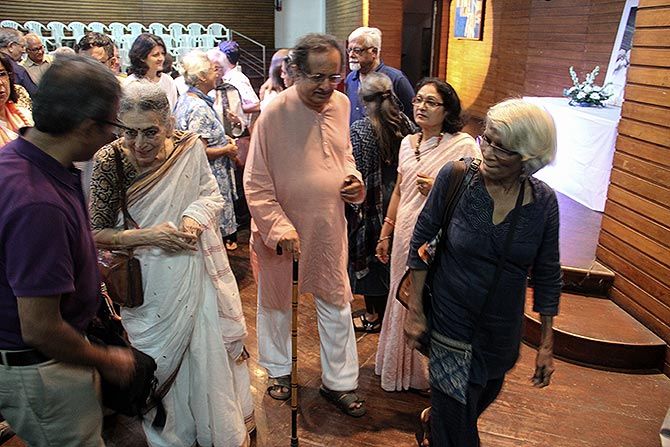
Lalita Lajmi, in a rare appearance, and K G Subramanyan's son-in-law Padmanabhan were there as well.

